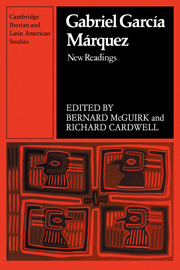Book contents
- Frontmatter
- Contents
- Note on the translations
- List of contributors
- Introduction
- 1 Characterization in the early fiction of Gabriel García Márquez
- 2 Beware of gift-bearing tales: reading ‘Baltazar's Prodigious Afternoon’ according to Marcel Mauss
- 3 The body as political instrument: communication in No One Writes to the Colonel
- 4 Magical realism and the theme of incest in One Hundred Years of Solitude
- 5 Translation and genealogy: One Hundred Years of Solitude
- 6 The humour of One Hundred Years of Solitude
- 7 On ‘magical’ and social realism in García Márquez
- 8 Aspects of narrative structure in The Incredible and Sad Story of the Innocent Eréndira and her Heartless Grandmother
- 9 Language and power in The Autumn of the Patriarch
- 10 Writing and ritual in Chronicle of a Death Foretold
- 11 Free-play of fore-play: the fiction of non-consummation: speculations on Chronicle of a Death Foretold
- 12 A prospective post-script : apropos of Love in the Times of Cholera
- The solitude of Latin America: Nobel address 1982
- Select bibliography
- Index
3 - The body as political instrument: communication in No One Writes to the Colonel
Published online by Cambridge University Press: 05 November 2011
- Frontmatter
- Contents
- Note on the translations
- List of contributors
- Introduction
- 1 Characterization in the early fiction of Gabriel García Márquez
- 2 Beware of gift-bearing tales: reading ‘Baltazar's Prodigious Afternoon’ according to Marcel Mauss
- 3 The body as political instrument: communication in No One Writes to the Colonel
- 4 Magical realism and the theme of incest in One Hundred Years of Solitude
- 5 Translation and genealogy: One Hundred Years of Solitude
- 6 The humour of One Hundred Years of Solitude
- 7 On ‘magical’ and social realism in García Márquez
- 8 Aspects of narrative structure in The Incredible and Sad Story of the Innocent Eréndira and her Heartless Grandmother
- 9 Language and power in The Autumn of the Patriarch
- 10 Writing and ritual in Chronicle of a Death Foretold
- 11 Free-play of fore-play: the fiction of non-consummation: speculations on Chronicle of a Death Foretold
- 12 A prospective post-script : apropos of Love in the Times of Cholera
- The solitude of Latin America: Nobel address 1982
- Select bibliography
- Index
Summary
Has a work of fiction ever been as spuriously transparent as No One Writes to the Colonel? Crisp and direct to the point of being laconic, this tale of a retired colonel who waits away his life, dying of hunger for a pension which never comes, could well be just what it seems and nothing more: a brilliantly terse indictment of social injustice in Latin America. Certainly in 1961, when it was first published, the story was seen in this light, which is to say, that it was read on its most unmistakable level. More recently, critics such as Peter Earle and Graciela Maturo have duly noted the complex network of symbols which sustain the main theme of García Márquez's novella, recognizing, once and for all, how this author always delivers more than mere appearances. Earle, for one, notes at least three features instrumental to our understanding of No One Writes to the Colonel: 1) the novella has a musical structure programmed on the basis of two voices, ‘discouragement’ and ‘illusion’; 2) there is a dialectic between desire and death housed within the persona of the protagonist; and 3) the rooster, prize possession of the colonel's slaughtered son, must be seen as ‘an allegory of vigilance and resurrection’. Maturo's concerns are of a more religious nature: she views the chronological development in the light of the Christian liturgical calendar.
- Type
- Chapter
- Information
- Gabriel García MárquezNew Readings, pp. 33 - 44Publisher: Cambridge University PressPrint publication year: 1987
- 1
- Cited by

